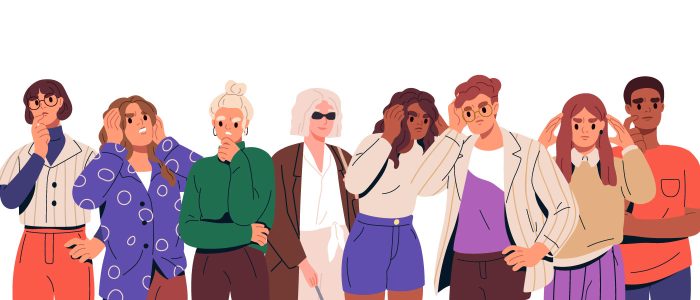What does the public think about Digital Accessibility?
On April 19th, 2022 we surveyed 560 U.S. consumers to capture public perceptions on disability and digital accessibility. Of the respondents, 56% have a disability and/or friends and family with a disability. Like every year surrounding Global Accessibility Awareness Day (GAAD), we believe it is important to reflect on the state of digital accessibility progress, so that we can understand what it takes to continue progress towards our common mission of digital equality.
Here are the results:
- 65% believe digital accessibility is a civil right and not just a privilege
- 54% of folks ages 55+ believe digital accessibility is a civil right
- 65% of folks ages 35-51 believe digital accessibility is a civil right
- 75% of folks ages 18-34 believe digital accessibility is a civil right
- 60% of respondents believe people with disabilities should access websites with the same experience as everyone else and not via separate digital experiences, such as overlays.
- 64% of folks ages 55+ believe people with disabilities should access websites with the same experience as everyone else
- 63% of folks ages 35-51 believe people with disabilities should access websites with the same experience as everyone else
- 53% of folks ages 18-34 believe people with disabilities should access websites with the same experience as everyone else
- 58% of respondents who have a disability and/or friends and family with a disability believe that people with disabilities should access websites with the same experience as everyone else
What does this mean?
Global Accessibility Awareness Day is more important than ever. While it’s encouraging that 65% of respondents believe digital accessibility is a civil right and not just a privilege, 40% of respondents still believe people with disabilities should access the web via separate experiences rather than the same ones as everyone else. Whether this group is responding to an unfamiliar subject, or truly believes separate treatment for people with disabilities is OK, they still need education and understanding on this subject.
Perhaps even more shocking is that the younger age groups (18-34), the generation known for making buying decisions aligned with their core values and famously sponsoring grassroots DEI initiatives across the country, only narrowly agree that people with disabilities should have the same web experience as everyone else. Just 53% support this opinion, the lowest percentage of all three age ranges. It’s possible they confused “separate” experiences with “personal” experiences, but this nuance should be more clearly explored.
It’s also possible that the perception of “separate” experiences being “equal” experiences is fueled by the general public’s lack of experience combined with hundreds of millions of venture capital funding going into accessibility overlay vendors. Regardless of the reason however, the equal and accessible web is still at risk. As you invest your attention in digital accessibility for GAAD, be wary of false claims, shortcuts and misinformation.
What Deque can offer to change this narrative
Across thousands of engagements, Deque has seen patterns for digital accessibility success formalize. These are founded on the requirement to offer equal experiences to all audiences, addressing accessibility issues as a matter of practice and not one-time or single-solution projects. We like to call this process “High Velocity Accessibility.” It brings the speed, efficiency, process, ownership and culture needed to sustain digital accessibility. Without it, regression is inevitable. This regression brings repeat lawsuits, costly retroactive troubleshooting, brand damage and lost market share.
What is High Velocity Accessibility?
High velocity accessibility is a streamlined approach that delivers results quickly without sacrificing accuracy or speed. It combines teamwork, robust process management, technology, and transparency to rapidly deliver sustainable and continuously improving accessibility from design through production. Get started with high velocity accessibility with these five steps:
Build an Accessibility Team
Bring together a small group of stakeholders from different product areas who share a dedication to spread awareness around accessibility across every team.
Get Executive Buy-In
The first job of the accessibility team is to earn executive sponsorship. Build this using four pillars that accessibility provides to every business: increased market share, increased alignment with social justice expectations, decreased operational costs, and decreased risk from negative legal action.
Create and Enforce an Accessibility Policy
Plan your path to success with incremental implementation, flexibility, room for exceptions, measurement, and accountability built in.
Use Technology to Support High Velocity
Affordable tools like axe DevTools Pro cost just $40/month and can catch 80% of all accessibility issues. This is an excellent place to start as you look to adopt tools to support your development and testing efforts. As you advance in maturity, you can integrate these tools into existing continuous integration/continuous deployment processes.
Implement Continuous Improvement
Use coaches and coaching techniques to broaden understanding and improve results. Use up-to-date assistive technology wherever possible, and maintain a high level of understanding and awareness of the needs of all those engaged with your business.
Summary
The digital accessibility industry is making great strides as awareness increases but we still have a ways to go before digital equality is a reality. As this year’s survey shows, the majority of people believe that digital accessibility is a human right that should not be deviated by separate experiences. GAAD is an important part of this movement. We hope that with the right education, process and technology, we can continue to improve the public understanding of this important work and drive meaningful change. For those of you advocating for digital equality today, thank you.
If you’re looking to help your friends, family or colleagues better understand disability or digital accessibility in a broader sense, attending our free training on GAAD is a great start. Deque University also offers self-paced online training.
